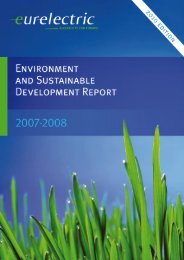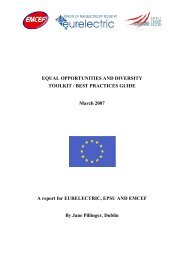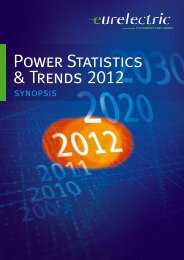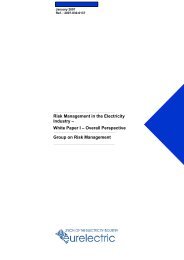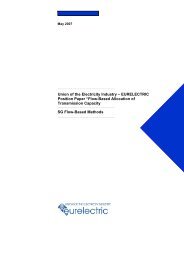Hydro in Europe: Powering Renewables - Full Report - Eurelectric
Hydro in Europe: Powering Renewables - Full Report - Eurelectric
Hydro in Europe: Powering Renewables - Full Report - Eurelectric
You also want an ePaper? Increase the reach of your titles
YUMPU automatically turns print PDFs into web optimized ePapers that Google loves.
Even though the permit process foresees public consultation, local communities and<br />
other stakeholders are often not fully satisfied with the participation opportunities<br />
offered by the formal plann<strong>in</strong>g process.<br />
Exist<strong>in</strong>g communications outreach work have hence been <strong>in</strong>tensified and took the<br />
form of a round table, which br<strong>in</strong>gs together all important stakeholders, <strong>in</strong>clud<strong>in</strong>g<br />
opponents to the project, to <strong>in</strong>crease the transparency of the decision-mak<strong>in</strong>g process.<br />
Reactions, especially on the political level have been very positive so far.<br />
2010 NREAP 2020<br />
W<strong>in</strong>d-Onshore 27 GW 36 GW<br />
W<strong>in</strong>d-Offshore 0.2 GW 10 GW<br />
Photovoltaic 17 GW 52 GW<br />
Biomass 6.3 GW 8.9 GW<br />
Table 5 Exist<strong>in</strong>g and projected capacities for renewable energy sources <strong>in</strong> Germany.<br />
Source: EURELECTRIC 2011, based on Power Statistics 2011; NREAPs; German Federal M<strong>in</strong>istry for the<br />
Environment, Nature Conservation and Nuclear Safety<br />
The future <strong>in</strong>tegration of these variable power quantities requires a swift extension of<br />
national and <strong>Europe</strong>an power storage capacities. The w<strong>in</strong>d does not always blow and<br />
the sun does not always sh<strong>in</strong>e at the exact moment when consumers’ power demands<br />
are high. Consequently, <strong>in</strong> order to make renewable energy available at times of peak<br />
demand, a large amount of storage capacity is required. Apart from the development<br />
of smart grids and the implementation of flexible generation plants, electricity storage<br />
facilities of any technology, such as pumped storage power plants, compressed-air<br />
reservoirs, accumulators, etc. will be of critical importance.<br />
Pumped storage power plants alone cannot cover the necessary storage demand <strong>in</strong><br />
the long term; research and <strong>in</strong>vestment <strong>in</strong>to “new” storage technologies is necessary<br />
too. However, it will take years before these technologies are marketable and can<br />
make a similarly large contribution to system stability as pumped storage plants<br />
already do today.<br />
To support the development of new storage technologies, all obstacles must be<br />
removed. Grid fees are one of these obstacles. Grid fees impede the construction of<br />
new power storage facilities, restrict the operation of exist<strong>in</strong>g facilities and <strong>in</strong>crease<br />
the burden on power networks.<br />
CASE STUDY 8 - Implementation of the EU WFD: challenges for hydropower<br />
<strong>in</strong> the Weser river bas<strong>in</strong> <strong>in</strong> Northern Germany<br />
Most run-of river hydropower plants located along the Weser River were orig<strong>in</strong>ally built<br />
to generate the required electricity to operate the ship locks of the German Midland<br />
channel.<br />
39



